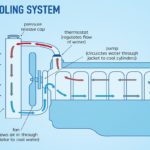Introduction
“Human comfort zone” how will you define it? As an automobile engineer we will define it as, an atmosphere that provides relax and causes less fatigue to a human which can be achieved by an air conditioning of the particular cabin that includes maintaining the cabin’s temperature between 20 to 25 degree centigrade and removing the humidity from the cabin’s atmosphere, in short by fitting air conditioner in that cabin but now the question arises How is it possible in a car’s cockpit? Who will provide power to the air conditioner in a car? Feeling curious? Let’s just find out.
A car air conditioning system consists of a compact version of the components of the normal air conditioner that has an evaporator, compressor, condenser, expansion device, and a fan which are fitted in a car to provide air condition inside the passenger’s compartment.
This air conditioning system takes power from the engine’s crankshaft and is operated by the passengers from the cockpit by pressing the button assigned to this system.
Why do We Need an Automobile or Car Air Conditioning System?
As we have already mentioned that air conditioning system inside a cabin is required to provide a relaxed and fatigue free atmosphere to the humans which in turn provides comfort which is essential for the health of a human being. But in a car it is required due to the following reasons.
- When a vehicle is running through cities like Delhi in India, passengers have to face lots of traffic that causes slow motion of vehicle due to which it is essential for a vehicle to be equipped with a system that can provide a comfort zone for the passengers.
- In India during summers there is lots of hot and humid air in the atmosphere which causes difficulty for a driver to drive and also for the passengers to travel, so during summer, an effective air conditioning system is required in a car which can provide a cool and humid free environment inside a passenger’s compartment.
- Air conditioning does not only condition the environment inside a passenger’s cabin but also provides filtered air which is very essential in cities like Delhi due to the very hazardous air pollution condition that can cause health issues to the passengers.
- In winters a vehicle faces a problem of fog or vapor formation over a front mirror which causes visibility problems and makes it difficult for a driver to drive a car, so it is essential for a vehicle to be equipped with a system that can fight with this problem.
- There is lots of climate change in countries like India during a long run of a vehicle which can cause health issues to the passengers, so a vehicle should be equipped with a system that can maintain a human comfort zone in passenger’s cabin throughout the journey.
Due to these problems, almost all the vehicle on the road today is equipped with an air conditioning system which nowadays becomes the basic need for human being.
Also Read:
- Types of Gearbox – Complete Explanation
- How DTSi Engine Works – Explained?
- Anti-lock Braking System (ABS) – Working Principle, Main Components with Advantages and Disadvantages
Components of Car Air Conditioning System.
The components of a car’s AC system is almost same as a room’s AC but there are lots of modification made in an automobile AC to make it compact and to fit it with engine’s component. The components used in automobile AC are-

1. Compressor –
It is also known as the heart of the AC system, A compressor provide pressure rise to the refrigerant to convert the vapour refrigerant into liquid refrigerant which in turn enables the further flow of the refrigerant through condenser.
- The compressor of the car air conditioning system is driven by the crankshaft of the engine through the belt drive.
2. Condenser –
It is the device looks like a small radiator and is used after the compressor as it provides condensing i.e. lowers the temperature, of the high pressure and high temperature liquid refrigerant sent by compressor through forced convection provided either by radiator fan or by separated fan used with condenser.
3. Expansion valve-
It is a device used in car air conditioning system to expand the high pressure, low temperature liquid refrigerant sent by the condenser in order to release pressure of the refrigerant before sending it to evaporator for the further process.
4. Evaporator –
It is a device that looks like another heat exchanger and is place just behind the AC vent over a dash board of a car, an evaporator takes heat from the passenger’s compartment and convert the liquid refrigerant sent by the expansion valve into vapor, which in turn provides cooling through the fan inside a passenger’s cabin
Note – Thermal expansion valve is used in vehicles that enable the passenger to change the temperature according to the requirement, by just adjusting the knob provided over a dashboard in passenger’s cabin.
5. Receiver-Dryer-
It is a safety catch used in an automobile or car air conditioning system as there is a chance that instead of vapors some liquid also flows towards the compressor which can damage the compressor, so the receiver dryer is used in between evaporator and compressor to convert that remaining liquid into vapors before sending it to compressor for compression.
6. Refrigerant –
It is the heat sensitive fluid with very low boiling point that is used in AC as a medium of heat exchanging.
Also Read:
- Valve Timing Diagram of Two Stroke and Four Stroke Engine
- How Automatic Transmission Works? – Best Explanation Ever
- How Spark Ignition Engine Works?
Working of an Automobile or Car AC
The working of an automobile AC system is also almost same as the normal AC but little difference is there-

1. The evaporator which is the another heat exchanger used in AC takes heat from the passenger’s cabin which in turn converts the liquid refrigerant flowing through the evaporator into vapors which in turn provide cooling with the help of the blower fan.
2. This vapor having high temperature low pressure is then sent to compressor which in turn increases the pressure over the vapors and converts the vapor refrigerant into liquid refrigerant.
- Now the refrigerant is in high pressure and high temperature liquid state.
3. This high pressure high temperature liquid refrigerant is then sent to the condenser which lowers the temperature of this refrigerant by forced convection provided by the radiator fan or by separated fan used.
- Now the refrigerant is having low temperature but the pressure of the liquid is almost the same.
4. This high pressure and the low-temperature refrigerant is then sent to the expansion valve which in turn releases the pressure from the refrigerant and converts it into its original state.
5. This refrigerant is then again sent to the evaporator for the further cycle.
For an excellent understanding about the working of a car AC system watch the video given below:
Note – Between evaporator and compressor a receiver dryer is used that convert the remaining liquid refrigerant from the evaporator into the vapors before sending it to the compressor.
- Receiver dryer also provide filtering of the system by absorbing the contaminated foreign materials inside the AC system.
So this is how an automobile or car air conditioning system is used in a vehicle which makes the drive comforting and provides health safety to the passengers. If you find this article informative and useful than don,t forget to share it.



![What are the Components of an Automobile? [Complete Guide] Main components of Automobile](https://mechanicalbooster.com/wp-content/uploads/2013/04/Main-components-of-Automobile-150x150.jpg)




